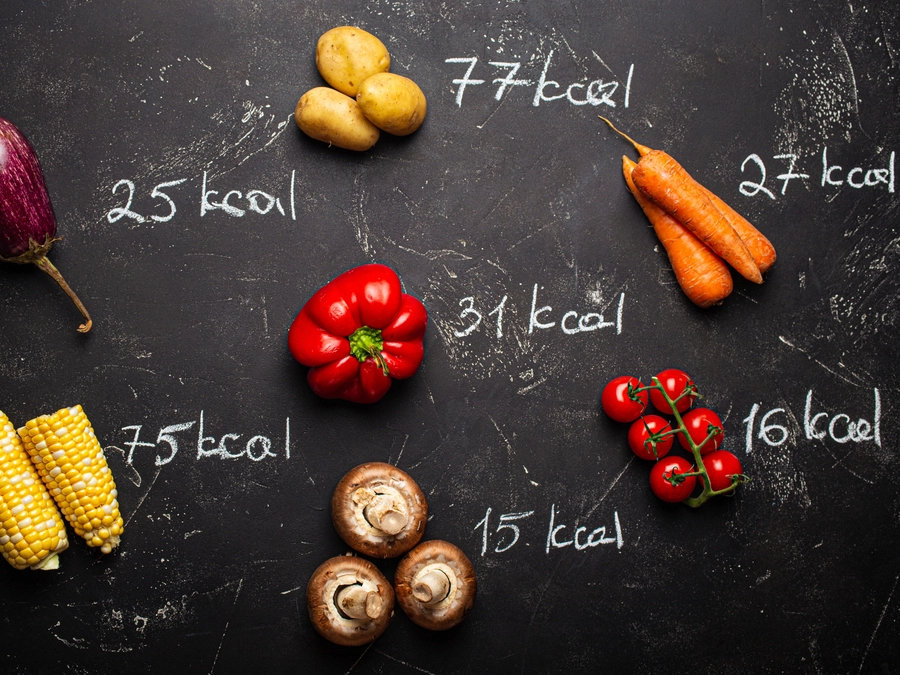Welcome



Are you curious about the buzz surrounding calorie deficits? Understanding the concept is pivotal for anyone looking to manage their weight effectively. This intriguing metabolic process can pave the way for meaningful weight loss, but it’s not just about cutting calories. It’s about striking the right balance between nutrition and energy expenditure.
In this article, we'll break down what a calorie deficit is, how it operates within your body, and what practical steps you can take to achieve it sustainably. Let’s dive into the science and strategy behind this essential concept!

At its core, a calorie deficit occurs when you consume fewer calories than your body expends through various activities and metabolic processes. This discrepancy prompts your body to seek alternative energy sources, primarily from stored fat, to meet its energy requirements. The result of this metabolic shift is weight loss, as the body burns fat reserves to compensate for the caloric shortfall.
To better understand a calorie deficit, it’s crucial to understand the function of calories in the body. Calories are units of energy we get from the food and drinks we consume. They fuel every bodily function, including metabolic processes and physical activities. When the caloric intake from food exceeds the body's energy expenditure, the surplus calories are stored as fat, causing weight gain. On the other hand, a calorie deficit forces the body to utilize stored fat for energy, facilitating weight loss.
Achieving a calorie deficit isn't merely about eating less; it’s about creating a balance that aligns with your individual energy needs. This balance means knowing your Total Daily Energy Expenditure (TDEE), which includes your Basal Metabolic Rate (BMR) — the calories your body needs to function at rest — plus the calories you burn through movement. Eating fewer calories than your TDEE creates a calorie deficit, which helps with weight loss. However, the challenge lies in maintaining this deficit in a sustainable and healthy manner, without depriving your body of essential nutrients.
Weight loss, fundamentally driven by a calorie deficit, is a complex interplay of metabolic processes. When you create a calorie deficit, your body begins to utilize stored fat for energy. This process is mediated by hormones and enzymes that regulate fat metabolism. One important hormone involved is insulin, which helps control blood sugar levels and how your body stores fat. When insulin levels are high, the body tends to store more fat. Conversely, lower insulin levels, achieved through a calorie deficit, promote fat breakdown.
Another critical aspect of the science behind weight loss is the role of the hormone leptin. It’s made by fat cells and helps control energy balance by reducing hunger. In a calorie deficit, leptin levels decrease, signaling the brain that energy stores are low. This can increase hunger and potentially slow down metabolism as the body attempts to conserve energy. However, with a well-structured diet and exercise regimen, these effects can be managed, allowing for sustained weight loss.
Moreover, muscle mass plays a crucial role in the weight loss equation. Muscles burn calories even when you're resting because they stay active all the time. When you lose weight, it's essential to preserve muscle mass to ensure a higher metabolic rate. Combining a calorie deficit with resistance training can help achieve this balance. Resistance training not only aids in preserving muscle mass but also enhances overall metabolic health, making it easier to sustain weight loss over time. Understanding these scientific principles is crucial for creating an effective, sustainable weight loss plan.
Finding the right calorie deficit for you means figuring out your Total Daily Energy Expenditure (TDEE) and choosing a realistic calorie cut. Start by estimating your Basal Metabolic Rate (BMR), which is the number of calories your body needs to keep basic functions like breathing and organ work going while at rest. You can use online calculators that consider your age, gender, weight, and height. For more precise results, use formulas like the Harris-Benedict or the Mifflin-St. Jeor.
Once you have your BMR, calculate your TDEE by adding your daily activity level. This includes all the calories you burn through moving and exercising. Activity levels usually fall into groups like sedentary, lightly active, moderately active, very active, and extra active. Multiply your BMR by the right activity factor to get your TDEE — the total calories needed to keep your weight steady.
To lose weight, eat fewer calories than your TDEE. A safe and common target is cutting 500 to 1,000 calories a day. This generally results in losing 1 to 2 pounds per week, which is healthy. Just be sure to keep getting enough nutrients by eating a wide range of nutrient-rich foods so you lose weight without risking your health.

Creating a sustainable calorie deficit involves more than just cutting calories; it’s about making mindful choices that support long-term health and well-being. One effective strategy is to focus on the quality of the calories you consume. Choose foods that are rich in nutrients like vitamins, minerals, and protein, instead of foods high in sugar and low in nutrition. Eating a mix of fruits, vegetables, lean meats, whole grains, and healthy fats can keep you full and help you stay within your calorie goal.
Another key to sustainability is portion control. Instead of drastically reducing portion sizes, aim to moderate them. Eating smaller meals more often can help control hunger and reduce the chance of overeating. Including high-fiber foods in your diet can also promote satiety, as fiber slows down digestion and helps you feel full longer. Drinking enough water during the day can support a calorie deficit. Sometimes, you might feel hungry when you're actually just thirsty, which can lead to eating more than you need.
Physical activity is important for keeping a calorie deficit going. Regular exercise helps burn extra calories and boosts your fitness and health. Doing both cardio and strength training can help you lose fat while keeping your muscles. Finding activities you enjoy can make it easier to stick with an exercise routine. Consistency is key, and integrating physical activity into your daily routine can help maintain a healthy calorie deficit without feeling deprived.
Crash diets, characterized by extreme caloric restriction and rapid weight loss, may seem enticing for quick results. However, they are often unsustainable and can lead to several negative health outcomes. Crash diets typically involve consuming very few calories, which can result in nutrient deficiencies, muscle loss, and a slowed metabolism. When your body doesn’t get enough nutrition, it slows down metabolism to save energy. This can make losing weight harder over time and increase the chance of gaining weight back when you start eating normally again.
In contrast, a moderate and sustainable calorie deficit promotes gradual weight loss, which is more likely to be maintained long-term. Slow and steady weight loss allows the body to adjust to the changes, minimizing the risk of muscle loss and metabolic slowdown. It also provides an opportunity to develop healthy eating habits and lifestyle changes that support overall well-being.
Moreover, a sustainable approach to weight loss prioritizes mental and emotional well-being. Crash diets can be mentally taxing, often leading to feelings of deprivation, frustration, and a negative relationship with food. On the other hand, a balanced and gradual approach encourages a positive mindset, fostering a healthier relationship with food and body image. This holistic approach supports weight loss and enhances overall quality of life, making it easier to maintain healthy habits and a stable weight in the long run.
The concept of a calorie deficit is often surrounded by myths and misconceptions that can hinder effective weight management. A common myth is that all calories are the same. At the same time, a calorie is a unit of energy, and where the calories come from matters. Foods like fruits, vegetables, lean proteins, and whole grains provide important nutrients for your health. On the other hand, sugary snacks and processed foods have calories but little nutrition and can lead to weight gain.

Another prevalent myth is that you need to cut out entire food groups to achieve a calorie deficit. This approach is not only unnecessary but can also be harmful. Excluding entire food groups can trigger nutrient deficiencies and a limited, unbalanced diet. Instead, focus on portion control and moderation. Incorporating a variety of foods from all food groups ensures that you receive a wide range of nutrients while still maintaining a calorie deficit.
A third myth is that exercise alone is enough to ensure a calorie deficit and achieve weight loss. While physical activity is important for weight management, it can’t be considered a substitute for a balanced diet. Exercise helps burn calories and improve overall fitness, but it should be combined with mindful eating habits to create a sustainable calorie deficit. Relying solely on exercise without addressing dietary habits can make it challenging to achieve and maintain weight loss goals.
Maintaining a calorie deficit while ensuring adequate nutrition is crucial for sustainable weight loss and overall health. One effective strategy is to focus on nutrient-dense, low-calorie foods that provide essential nutrients without excessive calories. Incorporate plenty of fruits and vegetables, which are rich in vitamins, minerals, and fiber, while being relatively low in calories. These foods can help you feel full and satisfied.
Lean protein sources such as chicken, fish, beans, and legumes play a key role in preserving muscle mass and increasing feelings of fullness. Because protein digests more slowly than carbohydrates, it helps you stay satisfied for longer. Adding a protein source to every meal can help control hunger and prevent overeating. Moreover, healthy fats found in avocados, nuts, seeds, and olive oil provide essential fatty acids and support overall health, while enhancing the taste and satisfaction of your meals.
Another key to eating enough while staying in a calorie deficit is mindful eating. Listen to your body’s signals of hunger and fullness, and control your portion sizes. Eating slowly and savoring your food can help you recognize when you’re satisfied, reducing the likelihood of overeating. Planning balanced meals and snacks throughout the day can also help manage hunger and prevent the temptation to overindulge.
Tracking your progress is crucial to ensure that your calorie deficit is effective and to make any necessary adjustments. One of the most straightforward methods is to monitor changes in your weight over time. Weigh yourself regularly, like once a week, at the same time and in similar conditions. Remember, weight can change for different reasons, so pay more attention to long-term patterns instead of day-to-day changes. A gradual, steady weight loss of 1 to 2 pounds per week is a good indicator that your calorie deficit is working.
In addition to tracking weight, consider monitoring other measurements, such as body circumference and body fat percentage. Measuring the circumference of your waist, hips, and other areas can provide insights into changes in body composition. Similarly, using tools like body fat calipers or bioelectrical impedance scales can help track changes in body fat percentage. These measurements can complement weight tracking and provide a more comprehensive picture of your progress.
Another important aspect of tracking progress is assessing how you feel physically and mentally. Pay attention to your energy levels, mood, and overall well-being. Sustainable weight loss should enhance your quality of life, not detract from it. If you’re feeling excessively fatigued, irritable, or experiencing other negative symptoms, it may be a sign that your calorie deficit is too aggressive or that your diet lacks essential nutrients. Adjusting your calorie intake, meal composition, or exercise routine can help address these issues and ensure a healthy, balanced approach to weight loss.
Physical activity boosts the number of calories your body burns, contributing to the overall energy expenditure. This can help create a larger calorie deficit without requiring drastic reductions in food intake. Cardiovascular exercises are particularly effective at burning calories and improving cardiovascular health. Aim for a mix of moderate to high-intensity cardio workouts to maximize calorie burn and support weight loss.
Strength training is another essential component of an effective weight loss plan. Building and keeping muscle is important because muscle burns more calories at rest than fat does. Incorporating resistance exercises, such as weight lifting, bodyweight exercises, or resistance band workouts, can help preserve muscle mass while promoting fat loss. Strength training also improves overall body composition, leading to a leaner, more toned physique.
Besides burning calories, exercise provides many other benefits that help with weight loss and overall health. Regular activity can lift your mood, lower stress, improve sleep, and increase your energy. These positive effects can make it easier to adhere to a calorie deficit and maintain healthy habits. Finding activities you enjoy and incorporating variety into your exercise routine can help you stay motivated and consistent. Remember, the most effective exercise plan is one that you can stick with long-term, making it an integral part of your lifestyle.
Embarking on a calorie deficit journey requires careful planning and mindfulness to avoid common pitfalls that can derail your progress. One significant mistake is setting an overly aggressive calorie deficit. Drastically reducing calorie intake can lead to nutrient deficiencies, muscle loss, and metabolic slowdown. Aim for a moderate calorie deficit that allows for gradual, sustainable weight loss while ensuring adequate nutrition.

Another mistake is neglecting the importance of balanced nutrition. Focusing solely on calorie reduction without considering the quality of your diet can lead to poor health outcomes. Ensure that your meals are well-balanced, including a variety of nutrient-dense foods that provide essential vitamins, minerals, and macronutrients. Avoiding extreme diets that eliminate entire food groups or rely heavily on processed foods can help maintain overall health and well-being.
Not drinking enough water is a common mistake. Staying well-hydrated is important for your health and can help with weight loss by making you feel full and helping digestion. Sometimes, your body confuses thirst with hunger, causing you to eat when you don’t need to. Try to drink water regularly throughout the day and keep an eye on how hydrated you are.
Finally, avoid the trap of all-or-nothing thinking. Weight loss is a journey that involves ups and downs. Occasional setbacks or deviations from your plan are normal and should not lead to feelings of failure or abandonment of your goals. Practice self-compassion and resilience, and focus on long-term progress rather than short-term perfection. By avoiding these common mistakes, you can create a sustainable, effective calorie deficit plan that supports your weight loss goals and overall health.
Finding the right supplements can help support your efforts when you're in a calorie deficit. Revolution Nutrition offers products that may make your plan easier to follow, especially when it comes to staying full, keeping energy levels up, and holding on to muscle while losing fat.
Protein powders from Revolution Nutrition can be useful when you're trying to hit your protein goals without going over your calories. Getting enough protein is key during a calorie deficit because it helps preserve muscle and keeps you feeling full. Our whey protein options come in many flavors, making it easier to enjoy low-calorie meals and snacks that support your goals.
If you're feeling low on energy while eating less, their pre-workout products may help. Our supplements are designed to give you a boost during workouts so you can stay active and burn more calories without feeling drained.